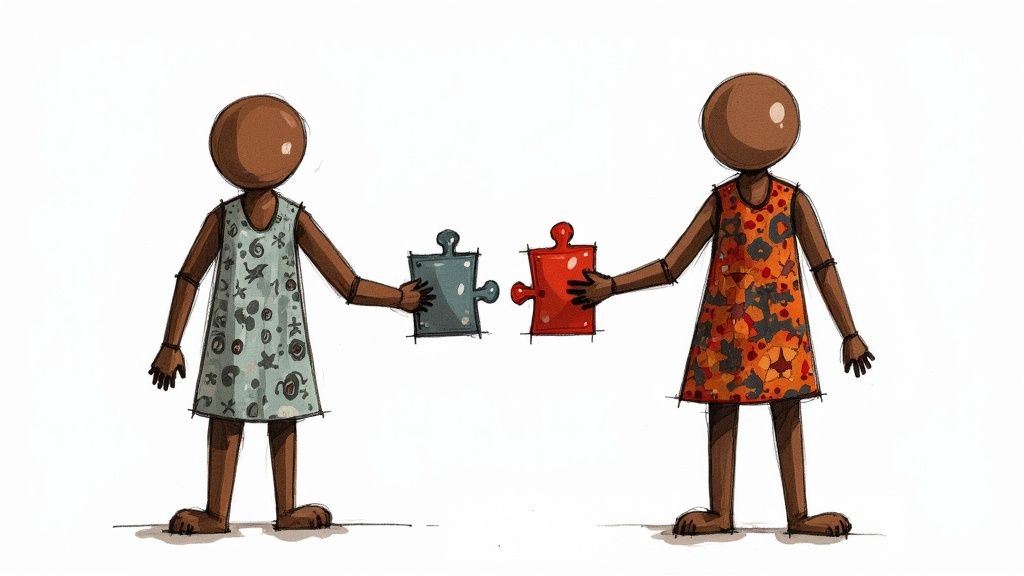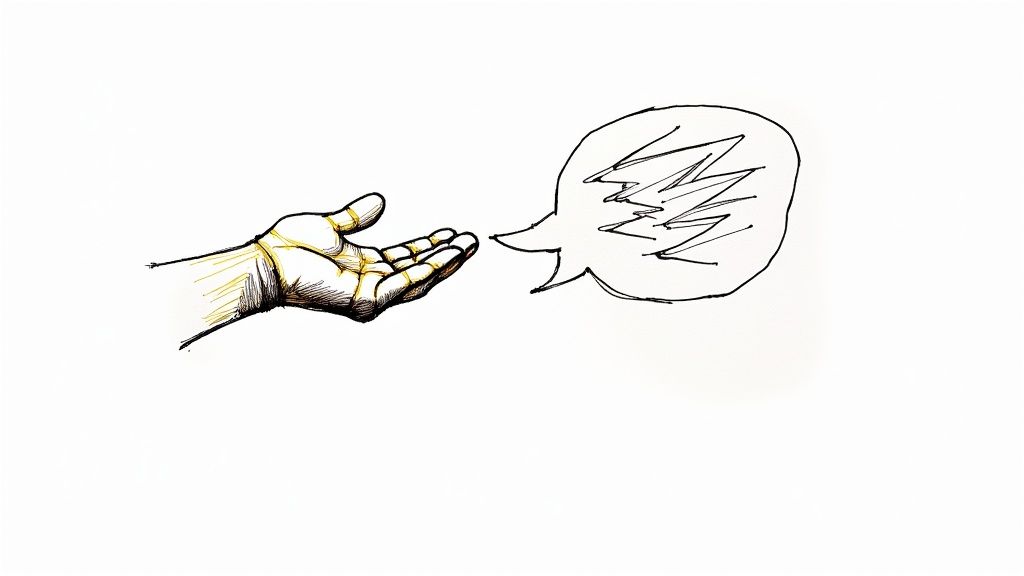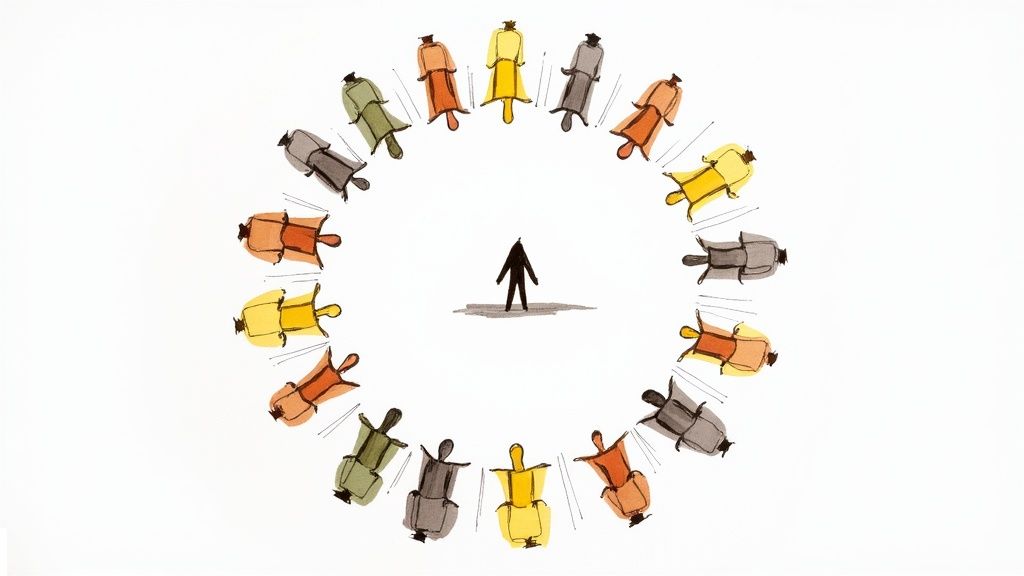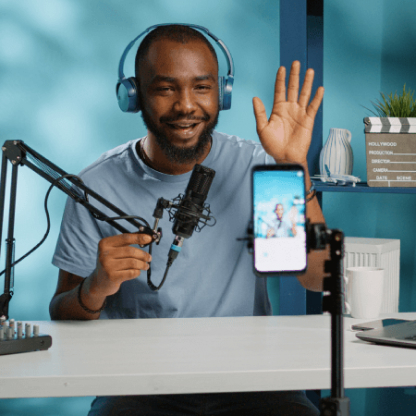Alright, let's be honest. Most "diversity interview questions" you find online are corporate fluff. They’re the kind of questions that get you rehearsed, HR-approved answers that tell you absolutely nothing about a candidate. I’ve sat through enough of those interviews to know they’re a complete waste of time. You’re trying to build a team that challenges norms and drives innovation, not one that’s just good at Googling "what is diversity?" five minutes before the call.
After building teams from the ground up—and making every hiring mistake in the book—I’ve learned that finding people who genuinely contribute to an inclusive culture requires digging deeper. It’s not about checking a box; it’s about understanding how someone thinks, acts when things get awkward, and what they’ll actually do when a colleague says something out of line. This is just one piece of the puzzle, of course. To really level up, you should integrate a broader range of high-impact diversity recruiting strategies.
So, here are the questions I actually use: the ones that separate the performative allies from the real culture-builders. These aren’t 'gotcha' questions. They’re conversation starters designed to reveal self-awareness, courage, and a genuine commitment to building something better. Let's get to it.
1. What does diversity mean to you?
This question seems like a total softball. It's not. It's your first and best filter for separating candidates who memorized DEI buzzwords from those who've actually thought about it for more than five seconds. Think of it as a vibe check to gauge their personal understanding beyond a dictionary definition.
There is no "correct" answer here. You're hunting for substance. A canned answer is a red flag. A great one moves past the obvious stuff like race and gender to include cognitive diversity, socioeconomic background, lived experiences, and neurodiversity. It shows they see diversity not as a compliance headache, but as a strategic weapon that drives innovation and better business outcomes.
How to Evaluate the Answer
Listen for specifics. Does their answer feel authentic or like they just read a blog post (maybe even this one)? A thoughtful candidate connects their definition to their actual job.
- A healthcare candidate might say something like, "It means building a team that actually looks like our patient population so we can provide culturally competent care."
- An engineer could frame it as, "It’s about cognitive diversity. You need different problem-solving approaches to avoid building fragile, buggy code."
- A finance pro might emphasize, "Diverse career paths challenge groupthink and stop us from making catastrophic risk assessments."
Actionable Tips for Interviewers
- Look for layers: Do they mention both visible (age, ethnicity) and invisible (thinking style, socioeconomic status) forms of diversity?
- Connect it to the bottom line: Do they get why it matters to the company’s goals, not just as a feel-good thing?
- Push back (gently): If their answer is vague, hit them with, "Interesting. Can you give me an example of how you've seen that in action?" This separates the thinkers from the parrots.
A shallow answer here is a pretty good sign that the rest of their responses will be just as superficial. Move on.
2. Tell me about a time when you worked with someone from a different background than yours.
This isn't just another boring behavioral question; it's a request for proof of life. You're moving past theory and asking for a receipt. This question forces candidates to recall a real-world scenario, revealing whether they merely tolerate differences or actually leverage them to get better results. It’s a classic for a reason: past behavior is the best predictor of future behavior.

You’re asking for a story. What you're listening for is the nuance. A weak answer is generic and basically says, "Yeah, we worked together and it was fine." A powerful answer shows curiosity, adaptation, and a genuine appreciation for how a different perspective made the work better. It separates the passive observers from the active collaborators.
How to Evaluate the Answer
Focus on the "Action" and "Result" parts of their story. Did they do something that showed empathy, or did they just… exist near someone different? Was the result a tangible improvement?
- A project manager could describe bridging the communication gap between a Boomer client who loves phone calls and Gen Z designers who live on Slack, landing a key contract.
- A teacher might talk about adapting their curriculum for refugee students, resulting in a measurable jump in class participation.
- An engineer could explain how collaborating with a global team across different time zones and cultural work styles caught a critical bug before it went live.
Actionable Tips for Interviewers
- Listen for the lesson: A great candidate will admit what they learned about their own biases or communication style. Follow up with, "What would you do differently next time?"
- Check for tokenizing: Do they describe the other person's background with respect, or does it sound like they're talking about a zoo animal?
- Connect action to outcome: The best answers draw a straight line from "I listened to a different perspective" to "we got a better result." If they don't, ask: "How exactly did that person's input change the final outcome?"
This question demands evidence. It filters out the people who can talk the talk but have never walked the walk.
3. How would you handle a situation where a colleague made an insensitive or discriminatory comment?
Forget hypotheticals—this is a behavioral litmus test. You’re asking a candidate to step into an uncomfortable moment and show you their playbook. This is what separates the passive bystander from the active ally. It reveals their courage and diplomacy when it’s not easy.

The goal isn't to trip them up. It's to see if they can think on their feet. A top-tier answer is nuanced. The worst answer is, "I'd immediately report it to HR." A better answer shows they think about the impact on the targeted person and the team dynamic before just escalating.
How to Evaluate the Answer
A great candidate knows this isn't a one-step process. They’ll describe a multi-faceted approach that is both immediate and strategic.
- An IBM engineer might describe pulling a teammate aside to address a biased assumption about a female colleague's technical skills, focusing on impact, not blame.
- A Starbucks manager could explain how they de-escalate a situation where a customer makes xenophobic comments to a barista, prioritizing their employee's safety above all else.
- An Accenture consultant might detail how they educated a client on microaggressions toward LGBTQ+ team members, turning a toxic moment into a teachable one.
Actionable Tips for Interviewers
- Look for balance: Do they mention both addressing the comment in the moment (if appropriate) and knowing when to escalate?
- Probe for context: Do they differentiate between a comment made from ignorance versus one from malice? Do they consider whether to address it publicly or privately?
- Who do they center? A strong answer centers the well-being of the person who was targeted.
- Add pressure: Ask a follow-up: "What if the person who made the comment was your boss?" This tests their integrity.
This question is a goldmine because it reveals character. For more on this, check out this guide on tackling workplace issues with grace.
4. Can you give an example of how you've contributed to creating an inclusive environment?
This is where the rubber meets the road. We're shifting from awareness to action. You're no longer asking for a definition; you're asking for a receipt. This question is critical because inclusive cultures are built by everyone, not just an HR department with a budget.

This question separates the culture champions from the bystanders. A great answer demonstrates initiative and impact, no matter how small. You're looking for tangible actions that show a candidate takes personal ownership of belonging. This isn't about grand, sweeping gestures; it’s about seeing a need and doing something about it.
How to Evaluate the Answer
Listen for the "why" behind the "what." A strong candidate won't just list an action; they'll explain the problem they saw, the solution they implemented, and the impact it had.
- A developer might share how they pushed for accessibility features after seeing a disabled user struggle with their product.
- A team lead could describe creating an anonymous feedback system to give quieter team members a voice.
- A new hire might recount starting an employee resource group for first-generation professionals to build community.
Actionable Tips for Interviewers
- Value all scales: A small, interpersonal action (like making sure a remote colleague is included in a conversation) is just as valid as a large, systemic change.
- Probe for impact: Ask, "What was the outcome?" or "What challenges did you face?" This reveals their problem-solving skills.
- Look for collaboration: Did they go it alone or seek input from the people they were trying to support? This shows they get that inclusion is a team sport.
These stories are powerful indicators of who will be a culture-add, not just a culture fit. And finding those people is exactly how company culture becomes a competitive edge.
5. Describe a time you had to adapt your communication style to work with someone.
This behavioral question cuts straight to cultural intelligence. It’s designed to see if a candidate has the self-awareness to realize their default communication style isn't one-size-fits-all. You're testing for empathy, listening skills, and their willingness to get uncomfortable to build bridges, not walls.
You're not looking for a story about speaking louder to someone who's hard of hearing. You want evidence of genuine adaptation. A strong answer reveals a candidate who can spot a communication breakdown, figure out why it's happening, and strategically change their approach. This skill is non-negotiable on diverse teams.
How to Evaluate the Answer
Listen for the "why" behind the change. Did they just guess, or did they seek to understand the other person's needs? A top-tier candidate will show a process of observing, reflecting, and then changing.
- A manager might describe switching from direct, public feedback to private, context-rich coaching for a team member from a culture where saving face is critical.
- A developer could explain creating detailed written docs instead of relying on verbal stand-ups after learning a colleague had auditory processing challenges.
- An account manager might recall shifting from a fast-and-loose American style to a more formal, detailed approach for German clients to build trust.
Actionable Tips for Interviewers
- Ask for the trigger: "What was the signal that told you a change was needed?" This reveals their emotional intelligence.
- Assess the outcome: Did their adaptation actually improve the relationship or the project?
- Check for learning: Did they treat it as a one-off thing or a lesson? A great follow-up is, "How has that experience changed how you communicate now?"
This question shows you who can truly connect and collaborate, not just clock in and out.
6. What strategies would you use to ensure all team members feel heard and valued?
This is where you find out if someone can actually lead. It moves beyond good intentions and asks for a practical, hands-on playbook for fostering psychological safety. It’s one of the most important diversity interview questions because it separates those who talk about inclusion from those who know how to build it.
You're testing if they understand the subtle dynamics that can silence people—like a loudmouth dominating a meeting or cultural differences in communication. They need to have concrete strategies to counteract that. This is vital for managers, but just as relevant for any senior team member.
How to Evaluate the Answer
The best answer is a toolkit, not a single hammer. It shows they get that inclusion isn't one-size-fits-all. Look for proactive strategies that go beyond the lazy "I have an open-door policy."
- A product manager might describe using a round-robin speaking order in brainstorming sessions so everyone contributes before anyone speaks twice.
- A remote team lead could talk about using anonymous digital feedback tools before a meeting to let introverts share ideas without pressure.
- An HR leader might discuss tracking speaking time in meetings to identify and coach away inequitable dynamics.
Actionable Tips for Interviewers
- Look for variety: Do they offer multiple strategies for different scenarios (verbal, written, one-on-one)?
- Assess proactivity: Are their tactics preventative or just reactive? Proactive is always better.
- Demand specifics: If they say, "I create a safe space," your only follow-up should be, "How? What specific actions do you take?"
- Check for feedback loops: Do they mention asking the team what works for them? A killer follow-up is, "How would you know if someone still isn't feeling heard?"
7. Tell me about a time your own bias or assumption was challenged.
Get ready to see some squirming. This question tests vulnerability, self-awareness, and a candidate's capacity for growth. Everyone has biases. Pretending you don't is a massive red flag. This prompt separates those who can reflect on their own screw-ups from those who can't—or won't.
This isn't a trap. It’s about finding out if they have the humility to learn. A great answer shows they can recognize a flawed assumption, take the L, and change their behavior. It reveals an emotional intelligence that's critical for any functional team.
How to Evaluate the Answer
You’re looking for genuine reflection, not a perfectly packaged humble-brag. The story itself is less important than what they learned from it.
- A developer might share, "I assumed a colleague with a non-technical title couldn't grasp an API issue. I was dead wrong; she was a former engineer and pinpointed the flaw in my logic. It taught me to never judge expertise by job title."
- A manager could say, "I realized I was unconsciously favoring candidates from certain universities, missing out on incredible talent. It forced me to overhaul my entire screening process."
- A teacher might admit, "I made assumptions about a student's home life based on their address and was humbled to learn the reality. It completely changed how I approach parent-teacher interactions."
Actionable Tips for Interviewers
- Listen for the lesson: Do they clearly state what they learned and how their behavior changed?
- Give credit: A strong answer often credits the person or situation that challenged them, showing they value other perspectives.
- Follow up: Ask, "How has that experience changed your approach since then?" This proves the growth was real.
- Watch for red flags: Be wary of answers that downplay the bias ("it wasn't a big deal"), blame others, or reveal a prejudice that's clearly still there.
How someone talks about being wrong says more about them than any "right" answer ever could.
8. How would you approach building relationships with team members whose experiences are totally different from your own?
This question cuts through the performative nonsense to see if a candidate can actually connect with other humans. It's not about asking them to be best friends with everyone; it's about their emotional intelligence and cultural humility. You're probing their ability to build genuine, respectful connections, which is the bedrock of any high-performing team.
The worst answer is a generic platitude like, "I treat everyone the same." A strong answer reveals a proactive and empathetic strategy. This question tells you if a candidate views diversity as a problem to be managed or an opportunity for growth.
How to Evaluate the Answer
Listen for a strategy that balances curiosity with respect. A great answer shows self-awareness and a willingness to learn, rather than placing the burden of education on their colleagues. It’s about building a bridge, not just watching from the other side.
- A consultant might describe scheduling informal coffee chats to understand a new teammate's background and work style before a project kicks off.
- A manager could talk about implementing 'personal user manuals' where team members voluntarily share their communication preferences to foster mutual understanding.
- A military veteran at a tech company might mention joining the Veterans ERG to connect with peers, but also intentionally attending other ERG events to broaden their perspective.
Actionable Tips for Interviewers
- Look for active verbs: Do they talk about listening, learning, asking, and adapting? That's the good stuff.
- Assess for genuine curiosity: Does their approach sound authentic or like a chore?
- Probe for self-awareness: A standout candidate might acknowledge their own privilege or potential blind spots.
- Follow up: Ask, “Can you give me an example of when you've done this successfully?” This forces them to show, not just tell. It's one of the most revealing questions you can ask.
Diversity Interview Questions Comparison
| Question Title | Implementation Complexity 🔄 | Resource Requirements ⚡ | Expected Outcomes 📊 | Ideal Use Cases 💡 | Key Advantages ⭐ |
|---|---|---|---|---|---|
| What does diversity mean to you? | Low – open-ended, conversational | Minimal – no preparation needed | Insight into candidate’s personal diversity views | Early-stage interviews; cultural fit assessment | Reveals depth of awareness; natural conversation starter |
| Tell me about a time when you worked with someone from a different background | Medium – requires STAR examples | Moderate – candidate reflection | Demonstrates real-world diversity collaboration | Behavioral interviews; assessing cross-cultural skills | Evidence-based; hard to fabricate; shows problem-solving |
| How would you handle a situation where a colleague made an insensitive comment? | Medium – situational judgement | Moderate – needs scenario prep | Reveals allyship, conflict resolution skills | Managerial/leadership roles; inclusion culture building | Tests values in action; shows emotional intelligence |
| Can you give an example of how you've contributed to creating an inclusive environment? | Medium – action-oriented examples | Moderate – candidate prep | Identifies proactive inclusion efforts | Leadership identification; culture champions | Distinguishes active contributors; reveals initiative |
| Describe a time when you had to adapt your communication style | Medium – behavioral, reflective | Moderate – requires examples | Assesses cultural intelligence and flexibility | Customer-facing roles; global teams | Demonstrates communication adaptability; emotional IQ |
| What strategies would you use to ensure all team members feel heard? | High – strategy explanation | High – requires thoughtful prep | Shows inclusive leadership and participation skills | Managerial roles; team leadership | Reveals practical skills; identifies potential leaders |
| Tell me about a time when your own bias or assumption was challenged | Medium – vulnerability testing | Moderate – needs reflection | Demonstrates self-awareness and growth mindset | Culture-focused roles; psychological safety | Shows maturity; openness to feedback; genuine learning |
| How would you approach building relationships with diverse team members? | Medium – behavioral, interpersonal | Moderate – requires examples | Reveals empathy, empathy, and bridge-building | Consulting; collaboration-heavy roles | Demonstrates emotional intelligence and cultural humility |
It's a Conversation, Not an Interrogation
Alright, let's land this plane. We've walked through a lineup of powerful diversity interview questions. But here’s the unvarnished truth: these questions aren't a magic spell. You can’t just read one off a script and expect a perfectly inclusive team to materialize.
The goal here is to spark a real conversation, not run an interrogation. These questions are diagnostic tools. They give you a glimpse into how a candidate thinks and behaves in the messy, wonderfully complex, and sometimes awkward world of human interaction. They help you see the person who will actually show up to your Monday morning stand-up, not just the one on the polished resume.
Key Takeaways: From Questions to Culture
Remember, the interview process itself is a massive signal. How you handle these conversations and react to their vulnerability says more about your company’s commitment to diversity than any mission statement ever could.
Let's boil it down:
- Go Beyond the Checklist: The value isn’t in asking the question; it’s in listening to the answer. Dig in, ask follow-ups, and look for self-awareness, not a perfect response.
- Context is King: A candidate’s story is a window into their real-world capabilities. Look for actions and outcomes, not just good intentions.
- Your Process is Your Pitch: A fair, structured, and respectful interview process is one of your best recruiting tools. It proves you practice what you preach before they even see an offer letter.
Building a diverse and high-performing team is a marathon, not a sprint. It starts with asking better diversity interview questions, but it’s sustained by creating an environment where the incredible people you hire can actually thrive. Now, go make your next interview count.
Ready to build a fairer, more efficient hiring process? Async Interview helps you standardize your initial screening with asynchronous video interviews, ensuring every candidate gets the exact same questions and a consistent, bias-reduced experience. Try Async Interview today and see how to make your top-of-funnel hiring smarter, not just harder.




